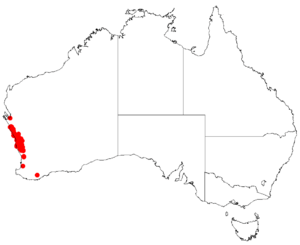Hakea auriculata facts for kids
Quick facts for kids Hakea auriculata |
|
|---|---|
| Scientific classification | |
| Genus: |
Hakea
|
| Species: |
auriculata
|
 |
|
| Occurrence data from Australasian Virtual Herbarium | |
Hakea auriculata is a beautiful shrub that grows only in Western Australia. It belongs to a plant family called Proteaceae. When this plant is fully blooming, it has very showy flowers. These flowers can be creamy white, yellow, dark red, or reddish-purple. They also smell very nice!
What it Looks Like
Hakea auriculata is a compact shrub that grows upright. It can reach a height of about 0.5 to 2.5 metres (1.6 to 8.2 ft). This plant has a special woody swelling at its base called a lignotuber. This helps it regrow after fires.
Its smaller branches can be covered in long, soft hairs or be smooth. The leaves are usually smooth and shaped like an egg, wider at the top. They are about 2 to 5.5 centimetres (0.8 to 2.2 in) long and 8 to 36 millimetres (0.315 to 1.417 in) wide. The leaves have teeth along their edges, usually 1 to 7 teeth on each side. These teeth are spaced about 1 to 10 millimetres (0.039 to 0.394 in) apart. The tips of the leaves are narrower and spikier.
The flowers grow in clusters called an inflorescence. Each cluster has 4 to 12 pink-cream flowers. They grow on a small stem about 2–4.5 mm (0.08–0.2 in) long. This stem can have short or long soft hairs, or it can be smooth. You can see these flowers from June to October. They appear where the leaves meet the stem.
The flower parts that look like petals, called the perianth, are greenish-white or pink. They are about 2.5 to 4.5 mm (0.098 to 0.177 in) long. The pistil, which is the female part of the flower, is about 7 to 11 mm (0.276 to 0.433 in) long.
After flowering, the plant produces fruits. These fruits are egg-shaped, wider near the stem, and about 15 to 25 mm (0.59 to 0.98 in) long. Their surface is rough and has many curving spines. Each fruit ends with a small, blunt beak. Inside, the seeds are about 17 to 19 mm (0.67 to 0.75 in) long. They have a wide wing on only one side, which helps them fly away in the wind.
How it Got its Name
The plant Hakea auriculata was first officially described in 1855. A botanist named Carl Meissner gave it its name. This happened in a scientific book called Hooker's Journal of Botany and Kew Garden Miscellany.
The second part of its scientific name, auriculata, comes from a Latin word. Auricula means "lobe of the ear" or "little ear." This name was chosen because of the shape of the base of the leaf, which looks a bit like a small ear.
Where it Lives
Hakea auriculata is a plant that is endemic to Western Australia. This means it is found naturally only in this area. It grows along the west coast in regions like the Wheatbelt and Mid West.
You can find it growing between the towns of Northampton and Gingin. It likes to grow in sandy areas with low-growing shrubs, called heaths. It also grows among stony hills and rocky outcrops, sometimes on laterite (a type of soil) or granite rocks.

